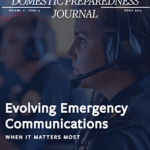- Articles, CBRNE, Communication & Interoperability, Critical Infrastructure, Emergency Management, Emergency Medical Services, Fire, Hazmat, Hospitals, Law Enforcement, Military, Public Health, Transportation
- by: Judy Kruger & Chris Paquet
The emergency preparedness workforce (police, paramedics, emergency managers, public health professionals, nurses, and doctors) was impacted by the relentless and unceasing large-scale public health response to COVID-19. For many, COVID-19 led to an expansion of more complex, intense, and demanding work, resulting in increased stress levels. Sometimes, the workday was longer due to additional assigned tasks to an already busy schedule. Managing pre-assigned daily tasks became more challenging due to the sudden changes in staffing due to staff absences, extended workdays, shift changes, and reassignment to different roles – all intensified response activities.
The prolonged nature of the pandemic resulted in an exhausted workforce with high depression rates among health and public service responders. A report from the Association of State and Territorial State Officials found that sustained efforts to respond to the ongoing pandemic took a toll on the workforce with increased absenteeism, high turnover, and low morale. The mental and physical burden of the pandemic required the introduction of protective measures to reduce burnout. Almost three years of the pandemic and simultaneous catastrophic events – such as wildfires, coastal and river flooding, and hurricanes – have resulted in many agencies losing staff and looking for solutions to address burnout.
Workforce development strategies help reduce burnout, optimize health, and enhance well-being in the emergency preparedness workforce.
In the early days of the pandemic, agency policies for first responders were ill-equipped to manage a long-term coordinated infectious disease response during a workforce shortage. As a result of COVID-19, many first-line responders sought other short- and long-term career choices. A report by Charles Sturt University interviewed 1,542 Australians who provided essential services during COVID-19 and found that more than 50% of first responders reported high levels of burnout, and 40% considered quitting their jobs. The American Psychological Association (APA) defines burnout as “physical, emotional or mental exhaustion, accompanied by decreased motivation, lowered performance and negative attitudes towards oneself and others.”
A 2020 survey by Eagle Hill Consulting found that 35% of employees who reported burnout said it was attributable to the pandemic. When further probed about the leading causes of employee burnout, responses varied: workload (47%); balancing work and personal life (39%); lack of communication, feedback, and support (37%); time pressures and lack of clarity around expectations (30%); and performance expectations (28%). Retaining and engaging employees who manage multiple events require organizations to assist them with solutions to balance work and their personal life. Organizations must innovate and organize around complex missions. During COVID-19, some organizations requested temporary assistance from the National Guard to support the continuous delivery of services.
Constant State of Response
In the aftermath of the COVID-19 pandemic and the need to remain vigilant to other biological threats, the emergency preparedness workforce likely will be in a constant burnout zone. Therefore, organizations must consider what they can do to support the workforce. The impact of mental and physical stress on the body leads to the release of stress hormones and activation of the stress-response system. In a high-alert, survival mode, the mind and body try to combat danger at the same time. Although helpful in responding to acute threats, chronic stress can tax the body and result in physical and mental health problems such as fatigue, loss of energy, or loss of appetite.
Disruption of typical social structures for emergency preparedness workers reduced access to traditional coping mechanisms, such as social connections. For example, the Harris Poll found that 61% of essential workers reported being unable to see their loved ones in person over the two prior years due to the pandemic. Similarly, they could not access stress-relieving activities such as going to a gym or yoga or hobbies such as in-person reading circles.
The Harris Poll conducted a Pandemic Anniversary Survey of 3,012 U.S. adults 18 years or older that cast a light on the long-term impact on the workforce. The study suggested that the pandemic brought a multitude of stressors as COVID-19 brought uncertainty about the future, new COVID-19 strains, and the inability to see friends and family. The study concluded that post-pandemic recovery would require operationalizing a holistic process through workforce strategies to develop resilience. Leaders in this field need to begin the restorative process and identify forms of healing that can alleviate the inner damages suffered during the pandemic while incorporating response and recovery into emergency planning.
The Complexity of Interacting With the Public
During COVID-19, some researchers found that healthcare workers were conflicted because the people or communities they served did not share the same deeply held values and beliefs. Also, they were not always treated with positive regard because of fear of infection, concern about spreading COVID-19 to others, and lack of trust in the healthcare system. The authors suggested that psychological consequences mirrored symptoms similar to post-traumatic stress and emphasized healthcare administrators seek innovative approaches to enhance staff’s well-being. Other suggestions for reducing burnout and helping with retention include adjusting shift schedules and lengths to maximize staffing and preventing fatigue and burnout; peer-to-peer support; and providing other needs of staff to help reduce stress such as childcare, eldercare, and alternate housing. Following are examples of self-care guides, trainings, and tools to reduce burnout and build resilience for healthcare workers and other first responders:
-
Emergency Responder Self-Care Plan – U.S. Department of Health and Human Services Assistant Secretary for Preparedness and Response (ASPR)
-
Topic Collection: COVID-19 Behavioral Health Resources – ASPR TRACIE (Technical Resources, Assistance Center, and Information Exchange)
-
COVID-19 and Healthcare Professional Stress and Resilience – ASPR TRACIE
-
Pandemic Workforce Well-Being: A Comprehensive Toolkit For Supporting Our Own During COVID-19 – Icahn School of Medicine at Mount Sinai
-
National Plan for Health Workforce Well-Being – National Academy of Medicine
-
Healthcare Provider Shortages: Resources and Strategies for Meeting Demand – ASPR TRACIE
Resilience Culture-Building Practices to Address Staff Burnout
The impact of reduced professional capability and efficiency due to burnout of frontline staff has been a growing concern long before COVID-19. To reduce workplace stress, organizations can provide resources and support as a standard practice in efforts to prepare workers better before an emergency happens. Findings from a February 2022 Harris Poll found that 20% of adults reported receiving treatment from a mental health professional since the start of the pandemic, and a large majority said they benefited from receiving support. However, 35% did not receive mental health treatment and said they could have benefited. Reasons for not receiving treatment from a mental health professional include:
-
Access-related issues (location timing and provider capacity),
-
Cost (co-pays and insurance coverage),
-
Lack of time,
-
Lack of knowledge on how to find a mental health professional,
-
The uncertainty of whether their issues warranted help, and
-
Concerns about stigma or other people finding out.
The APA defines resilience as the process and outcome of successfully adapting to complex or challenging life experiences. The COVID-19 response has shown how critical a trained and resilient workforce is to national security. Recent incidents in the United States and Puerto Rico show that empathy and compassion can help address the mental health impacts of disasters (e.g., hurricanes, earthquakes, and COVID-19) on emergency responders. The promotion of self-care, stress management, and resiliency can reduce the effects of cumulative stress during and after disasters and help responders improve physically and emotionally. Providing well-being programs in the workplace, such as mental health counselors and professional coaches, can bridge socio-emotional support gaps for staff.
Leaders responsive to restoring a sense of community and providing a supportive environment can help their staff remain resilient. To address the psychological toll of the pandemic, emergency preparedness leaders could consider the following to engage staff in the workplace and foster a culture of healing and resilience:
-
Frequently call, chat, and email to touch base with staff who are helping people in disaster operations;
-
Check in daily to confirm they are safe and not in harm’s way via automated messages;
-
Practice active and empathetic listening in workplace interactions and team-building techniques;
-
Facilitate coaching for staff and supervisors on techniques for having difficult conversations, collaborative problem-solving, and supporting each other during stressful times;
-
Offer and encourage mental health support, including counseling and paid mental health leave; and
-
Conduct recurring audits to evaluate which policies and practices are working well and identify opportunities for improvement that would promote staff resilience at the organizational level.
A Mercer survey found that employer support matters, and 41% of employees who reported receiving support during the pandemic were less likely to leave their job. The International Coaching Federation study found that managers and their team members that received coaching had enhanced well-being and performance during the pandemic. Group crisis intervention coaching creates connections among other first-line responders who have shared experiences and understand their struggles while helping them to feel less isolated. Likewise, individual coaching sessions create a space for staff to share their concerns and feel connected with coaches who are trained to listen, promote health and wellness practices, and acknowledge personal and professional challenges. Researchers suggest that the impact of being heard in a non-judgmental way can reduce experiences of stress. Even a 30-minute check-in session with a coach once every two weeks can go a long way toward making people feel connected.
Conclusion
Organizations have found themselves in a unique environment. A resilient culture is necessary to support the workforce, and organizations should consider integrating new culture-building practices. Scientific evidence is growing in support of making employees’ well-being a priority. The simple step of scheduling opportunities to listen to staff and offer peer support can help build camaraderie and can go a long way to building a resilient workforce.
As COVID community levels decrease, the emergency preparedness workforce will have to focus on post-pandemic recovery. Thus, to offset the extra demands on frontline staff, additional resources may be needed to better prepare workers before, during, and after critical events. Mental health counselors and individual and group crisis coaches can help state, local, tribal, and territorial emergency management offices to overcome challenges and foster resilience.

Judy Kruger
Judy Kruger, Ph.D., is an associate professor at Emory University in the Gangarosa Department of Environmental Health, Rollins School of Public Health. She is a certified business continuity professional (CBCP) and a certified emergency manager with Georgia Emergency Management and Homeland Security (GA CEM). She has responded to several national disasters and is a crisis coach, preparing business and industry leaders for business continuity and disaster response and recovery. She can be reached at jkruger@emory.edu
- Judy Krugerhttps://domesticpreparedness.com/author/judy-kruger
- Judy Krugerhttps://domesticpreparedness.com/author/judy-kruger
- Judy Krugerhttps://domesticpreparedness.com/author/judy-kruger
- Judy Krugerhttps://domesticpreparedness.com/author/judy-kruger

Chris Paquet
Chris Paquet is the assistant commissioner within the Office of Emergency Preparedness and Response (OEPR) at the New York City Department of Health and Mental Hygiene. Specifically, he oversees the Bureau of Healthcare and Community Readiness to build local capacity to respond and recover from disasters. He and his staff oversee policy issues, strategic planning, technological solutions, and communication efforts. On a national level, he chairs the National Preparedness Initiative started by the Centers for Disease Control and Prevention’s Office of Preparedness and Response. He has served in various Incident Command Structure roles during numerous emergencies such as Superstorm Sandy, Ebola, Measles, and COVID-19. He holds a BA from Wheaton College in Norton, an MA, where he now serves on the Board of Trustees, and a Master of Public Administration (MPA) from New York University’s Wagner School of Public Service. He is a graduate of Harvard’s National Preparedness Leadership Institutive and the Naval Postgraduate School’s Executive Leadership Program within the Center for Homeland Defense and Security. He can be reached at cpaquet@health.nyc.gov
- Chris Paquethttps://domesticpreparedness.com/author/chris-paquet






